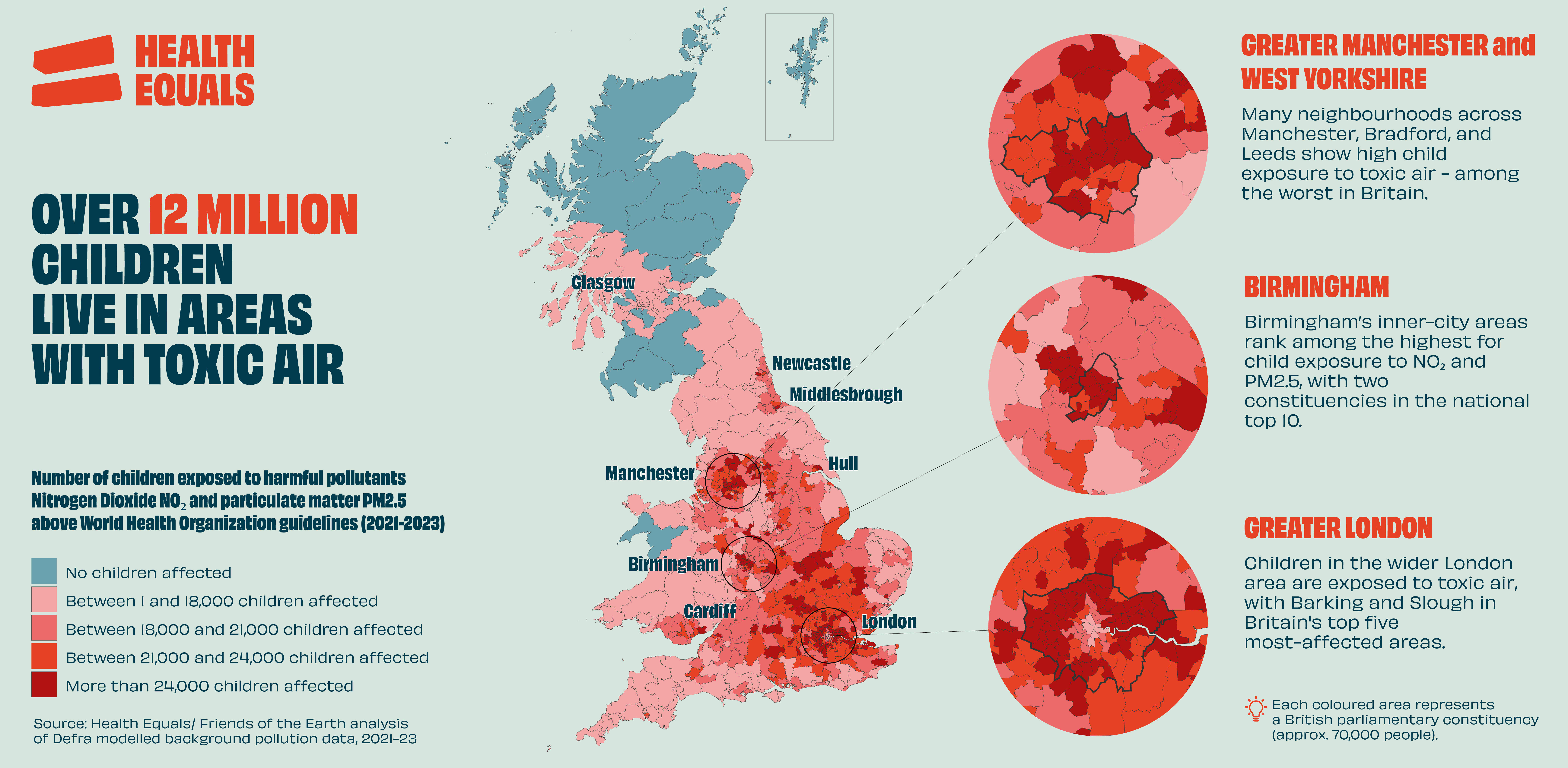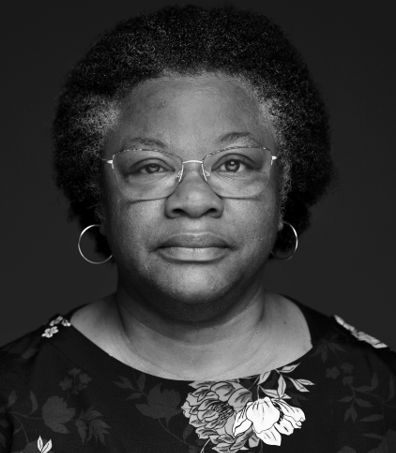Is that fAIR?
30,000 lives in the UK are cut short each year because of toxic air. And the reality is, almost all of us are breathing air that’s unsafe — breaking international health guidelines, year in, year out.
When we think about the impact of toxic air on our health, we often think of asthma and respiratory problems. But air pollution affects us from before our first breath to our last — with serious consequences that can shorten our lives. It worsens asthma and other lung conditions, increases the risk of heart disease and stroke, and has been linked to dementia, diabetes, and certain cancers.
And while air pollution affects almost all of us, its effects aren’t felt equally.
People already hit hardest by wider health inequalities are also breathing the dirtiest air: from children and younger people growing up near busy roads to more deprived communities facing financial hardship. People from ethnic minorities are also more exposed to high levels of pollution, simply because they’re more likely to live in areas with higher pollution, limited nature around them, and have underlying conditions that make them more vulnerable to its effects.
That’s not just unfair — it’s a health crisis. But it doesn’t have to be this way. There are actions we can take to make health equal and ensure that everyone has clean air to breathe.
You might not be able to see it, but the air we breathe and the environment around us is an essential building block for our health and wellbeing.
90% of us in Britain, including millions of children, are breathing toxic air that exceeds international health guidelines.


of people in Britain live in areas where the air breaches international air quality guidelines

lives in the UK are cut short each year because of toxic air

children in Britain live in neighbourhoods where pollution breached the World Health Organization guidelines
Explore stories from across the UK on how air pollution has impacted people’s lives, as well as ways that positive change is being made.
-
 Maksim
Manchester
Maksim
Manchester
I was diagnosed with asthma when I was seven, when I had my first asthma attack. I likely have asthma because of air pollution – I live next to one of the most polluted roads in the UK. Fighting for clean air is important because air pollution causes asthma and lung disease for young people – even when our lungs are still growing.
Maksim is a vocal clean air campaigner, inspired by his mother, Julia, who won a court case preventing the local council from creating a new car park next to his primary school.
She didn’t want me and my siblings to be breathing in polluted air. She showed me that everyone has a voice, including me.
Anjali and Maksim’s stories are being shared as part of our supporter Asthma + Lung UK’s “This is Life + Breath” photography exhibition. Photography credit: Chris O’Donovan
-
 Angela
London
Angela
London
Motivated by her own exposure to air pollution, Angela is the coordinator for Clean Air for Southall and Hayes – a campaigning group speaking out against the environmental damage caused by local gasworks.
When you go to a petrol station and you fill up your car with petrol, there’s a certain odour. Imagine that being multiplied many times, within your own home and surrounding environment. We are very, very close to the gasworks site. And we really experience terrible air pollution. It’s gone under the radar because we aren’t White, we aren’t affluent, we don’t control the levers to power.
-
Ibrahim Birmingham
Ibrahim is a secondary school teacher from Perry Barr in Birmingham. Growing up in nearby Lozells and working with children through schools and community organisations since the 1990s, he’s witnessed first-hand how air pollution is impacting health — not just in his students, but in his own life and family.
The number one issue in Lozells and Perry Barr is the number of cars — it’s just unreal now. Unless you live by a park, it feels like a hotbox. You can feel the fumes, to the point where you can taste it. We take children on trips to the Lake District or open parks, and they always say the air feels different. Most of them can’t get out, can’t move, can’t go on holidays — they just stay in this hotbox climate. It’s heartbreaking. You just want to see children happy and getting on with their lives.
-
Linda North Tyneside
The smell was terrible. You could taste it on the back of your throat.
Linda, 72, has spent decades fighting for her community in East Howdon, where the persistent stench from nearby sewage works has deeply affected residents’ mental health.
You felt dirty, like you stank. You didn’t want to invite friends and neighbours over because you were embarrassed. You felt like a second-class citizen.
People are anxious all the time because you don’t really know what it’s doing to you. You know it can’t be good for you, but no one seems bothered. That does make you feel very anxious.
-
 Anjali
London
Anjali
London
People like us, living in poorer areas of London and from marginalised communities, were being overexposed to air pollution but no one was really talking about it. We felt this was awful because our lives were clearly being valued less than the lives of people from richer neighbourhoods and different backgrounds. That’s why we set up this campaign – to make sure our lives would be protected.
Anjali went to primary school with Ella Adoo-Kissi-Debrah, who died aged nine after an asthma attack and was the first person in the world to have air pollution listed as a cause of their death. Anjali and her friends were so angry about the impact of toxic air on Ella and everyone else living in the most polluted areas of south London, they created the Choked Up campaign to raise awareness.
Anjali and Maksim’s stories are being shared as part of our supporter Asthma + Lung UK’s “This is Life + Breath” photography exhibition. Photography credit: Chris O’Donovan
-
Sinead Manchester
Working as a GP in Levenshulme, South Manchester, Dr Sinead Millwood has frontline experience treating people for the health-related impacts of poor air quality.
Air pollution is easy to ignore because it is invisible. But it is there, and there is so much evidence showing how serious the health effects of air pollution are. Air pollution is a social justice issue because most people who are struggling with its health effects are living in the worst places for it. And the reason for that is because the cheaper housing and the social housing is on main roads.
We hit the streets to ask the public what they really think about toxic air
Clean air is just one of the ways we can make sure everyone has their best chance of good health. We’re calling for a cross-government health inequalities strategy that puts health at the heart of government — from setting realistic but ambitious targets to reduce health inequalities to establishing clear roles for all departments to prioritise and restore the building blocks of health.
On clean air, the government is reviewing its air quality targets, and we all have a part to play in making sure those targets are bold enough to give everyone the chance to breathe cleaner air and bring World Health Organization air quality guidelines into UK law.
Along with our members, we want to make sure those targets are bold enough to clean up our air.
Toxic air is just one part of the problem. The world around us shapes our health – from good-quality homes to stable jobs, social connections, and neighbourhoods with green space and clean air.
When these building blocks of health aren’t in place, we’re held back from good health.
To change this, we need bold action across all the building blocks of health, starting with the air we breathe. To be part of the solution, you can call on your MP to commit to #MakeHealthEqual so that we can all live longer, healthier lives.
Some people in the UK are living up to 16 years less than others in the UK.
Breathing toxic air is part of the problem.
Enter your postcode to explore what the life expectancy is where you live, and see how it stacks up against the national average.
Health Equals is a coalition of over 85 organisations who are all working in their own way to address the building blocks of health, including cleaning up the air we breathe.
With your help, your MP can commit to making equal health a reality.
Write to themStay informed
Sign up to join our campaign network and receive updates on how you can help shape a society where each of us has the best chance of good health, no matter where we live, work or were born.
Sign up to find out more about our campaigns and how you can help shape a society where each of us has the best chance of good health, no matter where we’re born.
-
What is toxic air? Toxic air is made up of tiny particles and gases that come from things like traffic, factories, wood-burning stoves, and even construction dust. These pollutants float around in the air and get into our lungs every time we breathe.
Some of the most common ones are:
- Tiny particles (called PM2.5) that are so small they can get deep into your lungs and even into your bloodstream.
- Nitrogen dioxide, mostly from car exhausts, which is especially bad for people with asthma or other lung problems.
- Ground-level ozone, which builds up in hot weather and can make it hard to breathe.
Breathing toxic air has serious health consequences, from worsening asthma and other lung conditions to increasing the risk of heart disease and stroke, and being linked to dementia, diabetes, and certain cancers.
If you want to find out more, visit Global Action Plan’s Clean Air Hub.
-
What is a 'safe' level of air pollution? There is no safe level of air pollution. The legal UK annual average limit for compliance with nitrogen dioxide is four times higher than the World Health Organization guidelines. Defra share recommended health advice for at-risk individuals and the general population depending on the air pollution levels.
-
Where did you get the data used in the air pollution infographic from? Friends of the Earth analysed Defra’s modelled background pollution data by neighbourhoods (Lower Super Output Areas (LSOAs) in England and Wales; Data Zones in Scotland) to derive 3-year average pollution concentrations for PM2.5 and NO2 in 2021-23. The 3-year average pollution concentrations for PM2.5 and NO2 were compared with WHO air quality guidelines, and neighbourhoods were categorised based on the extent to which air pollution levels exceeded these guidelines.
Neighbourhoods were classified as follows:
- Both PM2.5 and NO2 concentrations below WHO guidelines
- Either PM2.5 or NO2 concentrations above WHO guidelines
- Either PM2.5 or NO2 concentrations twice WHO guidelines (also classified as ‘very high’ pollution areas)
Demographic data on schools and populations were appended to the dataset. The data was summarised to Westminster constituencies by counting the numbers of different types of air pollution neighbourhoods in each constituency and summarising the demographics within these constituencies. This allows the data to show the total number of schools or children in areas with high or very high air pollution in each constituency.
-
What else can I do to tackle poor air quality? Air pollution can feel invisible — and overwhelming. But whether you’re concerned about your own health, your children’s safety, or the environment more broadly, there are practical things you can do. You don’t need to be a scientist or campaigner to take meaningful steps. Here’s how you can protect yourself and take action where you live:
- Check air quality before you travel
Use apps or websites to check pollution levels near you. Global Action Plan’s Clean Air Hub and Clean Air Planner can help you understand the problem, avoid polluted air, and reduce the air pollution you create, both indoors and out. - Support or start a School Streets campaign
Advocate for road closures outside schools during pick-up and drop-off times to reduce children’s exposure to pollution. Resources from Clean Air Hub and local councils can help you get started. - Join or create a clean air group
Work with neighbours, local schools, or community groups to raise awareness and push for changes like better cycling infrastructure or traffic calming. - Talk to your local council or MP
Ask them to support policies that improve air quality — such as low-traffic neighbourhoods, clean bus fleets, and stricter air pollution limits.
- Check air quality before you travel
-
What is the government doing about air quality? In 2019, the UK government launched its Clean Air Strategy, which assesses their plans for dealing with sources of air pollution. This includes things like developing new guidance on things that create pollution like tyres, brakes, and wood stoves.
There is further the government can go by reviewing its air quality targets and bring World Health Organization air quality guidelines into UK law.
Local authorities have a number of responsibilities for local air quality. Every authority is required to regularly review and assess air quality in their area. They are also required to produce annual reviews of air quality, and action plans to improve or safeguard air quality within those areas. You can find the latest air quality reviews and plans on local authority webpages.
-
Where can I go for support related to the issues raised? We understand that this is a sensitive matter and could impact people in different ways. If you’ve been affected, please visit our support page.

